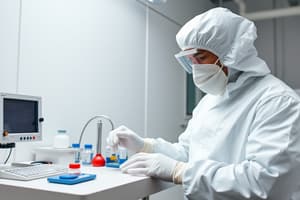Podcast
Questions and Answers
Static verification using correctness arguments is a key part of the Cleanroom process.
Static verification using correctness arguments is a key part of the Cleanroom process.
True (A)
In the Cleanroom software development process, defect removal is the primary focus.
In the Cleanroom software development process, defect removal is the primary focus.
False (B)
In the Cleanroom process, the software is executed during the development phase.
In the Cleanroom process, the software is executed during the development phase.
False (B)
The Certification team is responsible for developing and maintaining the system specification.
The Certification team is responsible for developing and maintaining the system specification.
Lint is a verification tool used for Java programs.
Lint is a verification tool used for Java programs.
The Cleanroom process involves incremental development.
The Cleanroom process involves incremental development.
The Cleanroom process uses statistical testing to determine program reliability.
The Cleanroom process uses statistical testing to determine program reliability.
Spin is a verification tool used for distributed systems.
Spin is a verification tool used for distributed systems.
Static analysis checks can replace manual code inspection.
Static analysis checks can replace manual code inspection.
Control flow analysis detects uninitialized variables.
Control flow analysis detects uninitialized variables.
Information flow analysis identifies anomalies in the program.
Information flow analysis identifies anomalies in the program.
Path analysis is used to review the consistency of routine and procedure declarations.
Path analysis is used to review the consistency of routine and procedure declarations.
Cleanroom software development is named after a code inspection technique.
Cleanroom software development is named after a code inspection technique.
Stages of static analysis generate only a small amount of information.
Stages of static analysis generate only a small amount of information.
Static verification techniques involve executing the program to detect errors
Static verification techniques involve executing the program to detect errors
Program inspections are not effective in discovering errors
Program inspections are not effective in discovering errors
The Cleanroom development process does not depend on static verification
The Cleanroom development process does not depend on static verification
Static analysis tools can discover program anomalies that may not be an indication of faults in the code
Static analysis tools can discover program anomalies that may not be an indication of faults in the code
Verification is the same as validation in software testing
Verification is the same as validation in software testing
Test plans are not necessary for guiding the testing process
Test plans are not necessary for guiding the testing process
Program code in inspections is checked by a large team to locate software faults
Program code in inspections is checked by a large team to locate software faults
Static analysis is a dynamic verification technique
Static analysis is a dynamic verification technique
Flashcards are hidden until you start studying
Study Notes
Cleanroom Software Development Process
- Philosophy is defect avoidance rather than defect removal
- Based on incremental development, formal specification, static verification, and statistical testing
Cleanroom Process Teams
- Specification team: develops and maintains system specification
- Development team: develops and verifies software without execution or compilation
- Certification team: develops statistical tests to exercise software after development, determines reliability using reliability models
Verification and Testing Tools
- Verification tools: lint for C, CheckStyle and PMD for Java, Spin for distributed systems
- Static analysis checks: control flow, data use, interface, information flow, and path analysis
- Automated testing tools: TestComplete, Siebel, Rational Robot, Mercury WinRunner, SIPP, and Ethereal
Key Points
- Verification shows conformance with specification, while validation shows the program meets customer needs
- Test plans should guide testing process
- Static verification involves examining and analyzing program code for error detection
- Program inspections are effective in discovering errors
- Static analysis tools can discover program anomalies indicating faults in code
- Cleanroom process depends on statistical testing to determine program reliability
Systems Interface
- Definition: shared boundary across which two or more separate components exchange information
- Types of interfaces: software, hardware, peripheral devices, humans, and combinations of these
- Examples: operating system interfacing with hardware, applications interacting via streams, objects interacting via methods in object-oriented programs
Studying That Suits You
Use AI to generate personalized quizzes and flashcards to suit your learning preferences.




